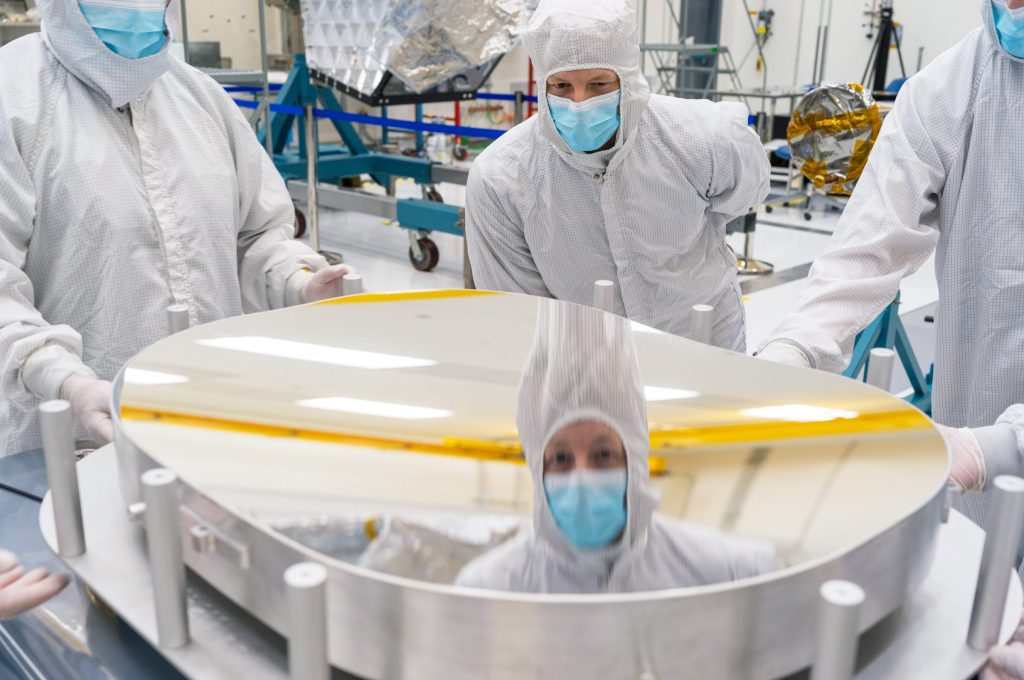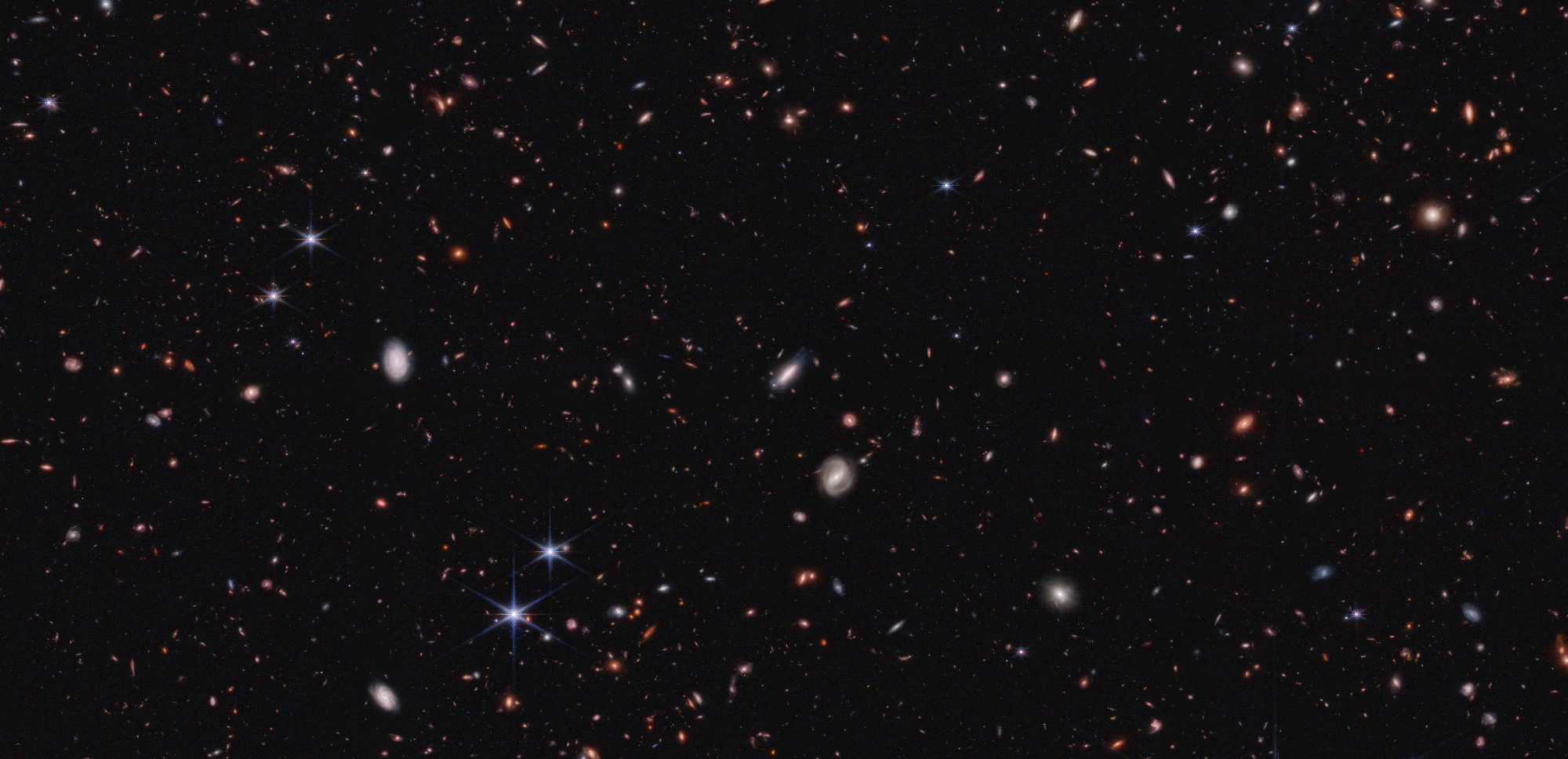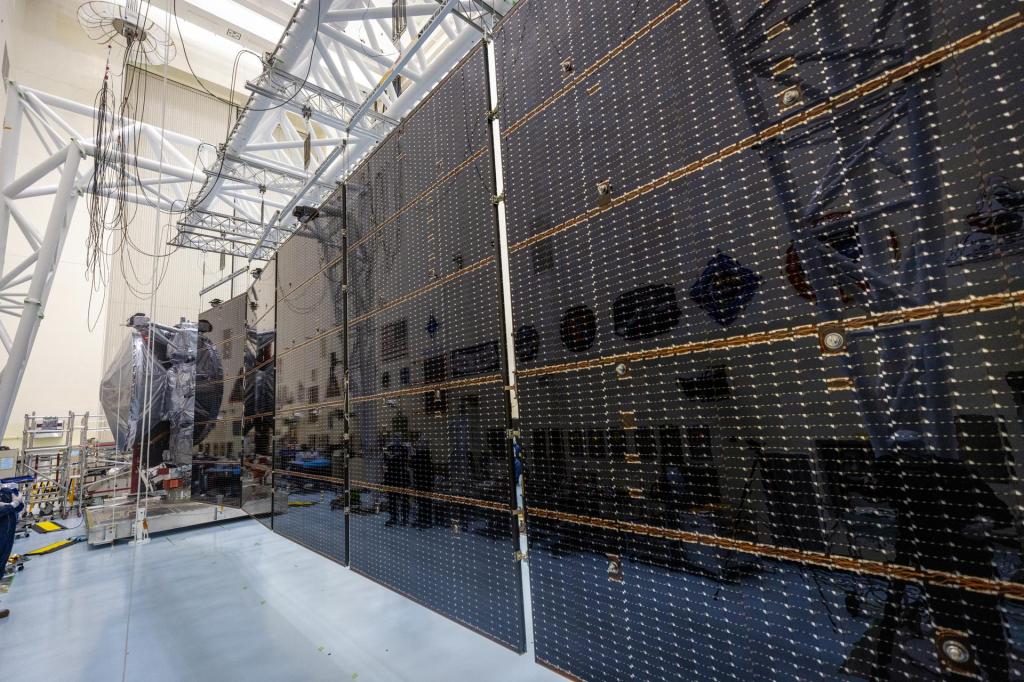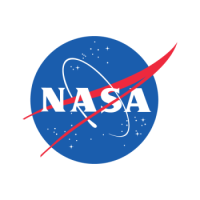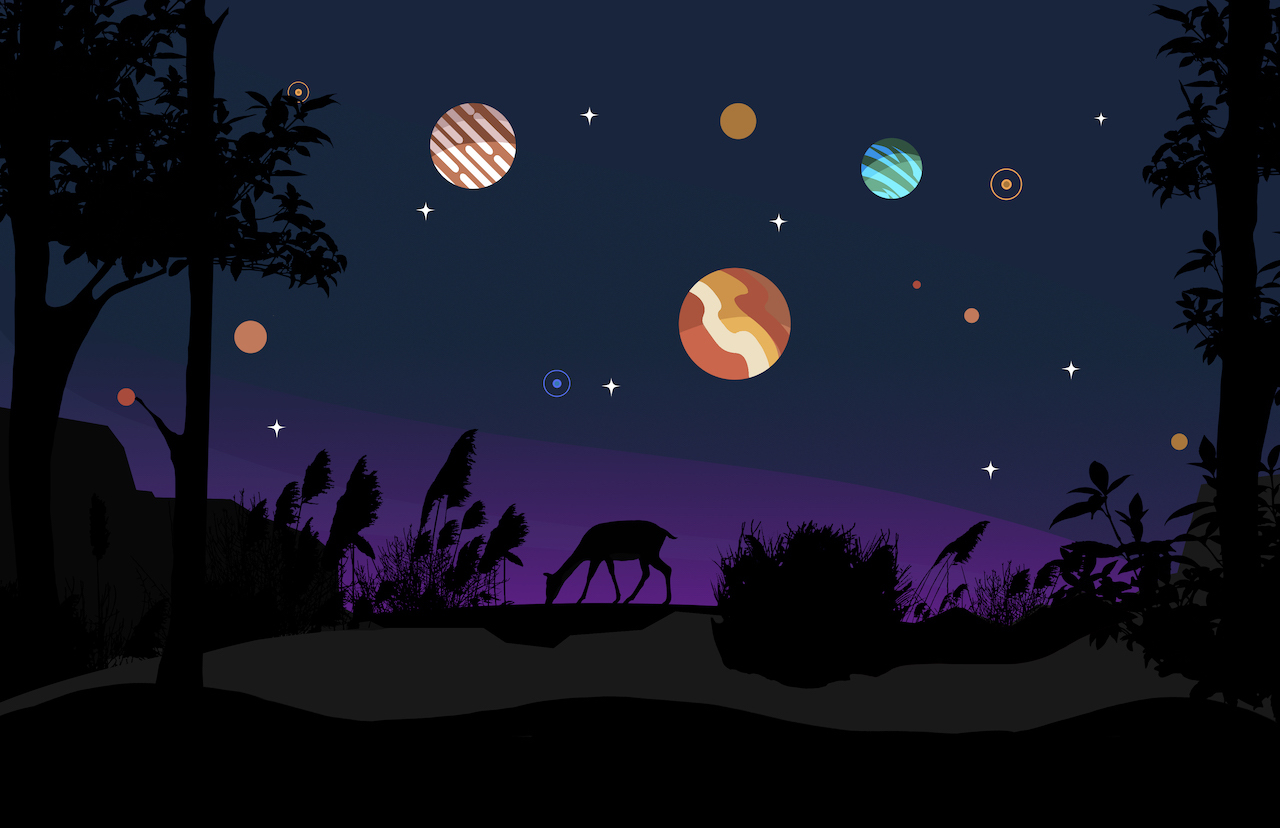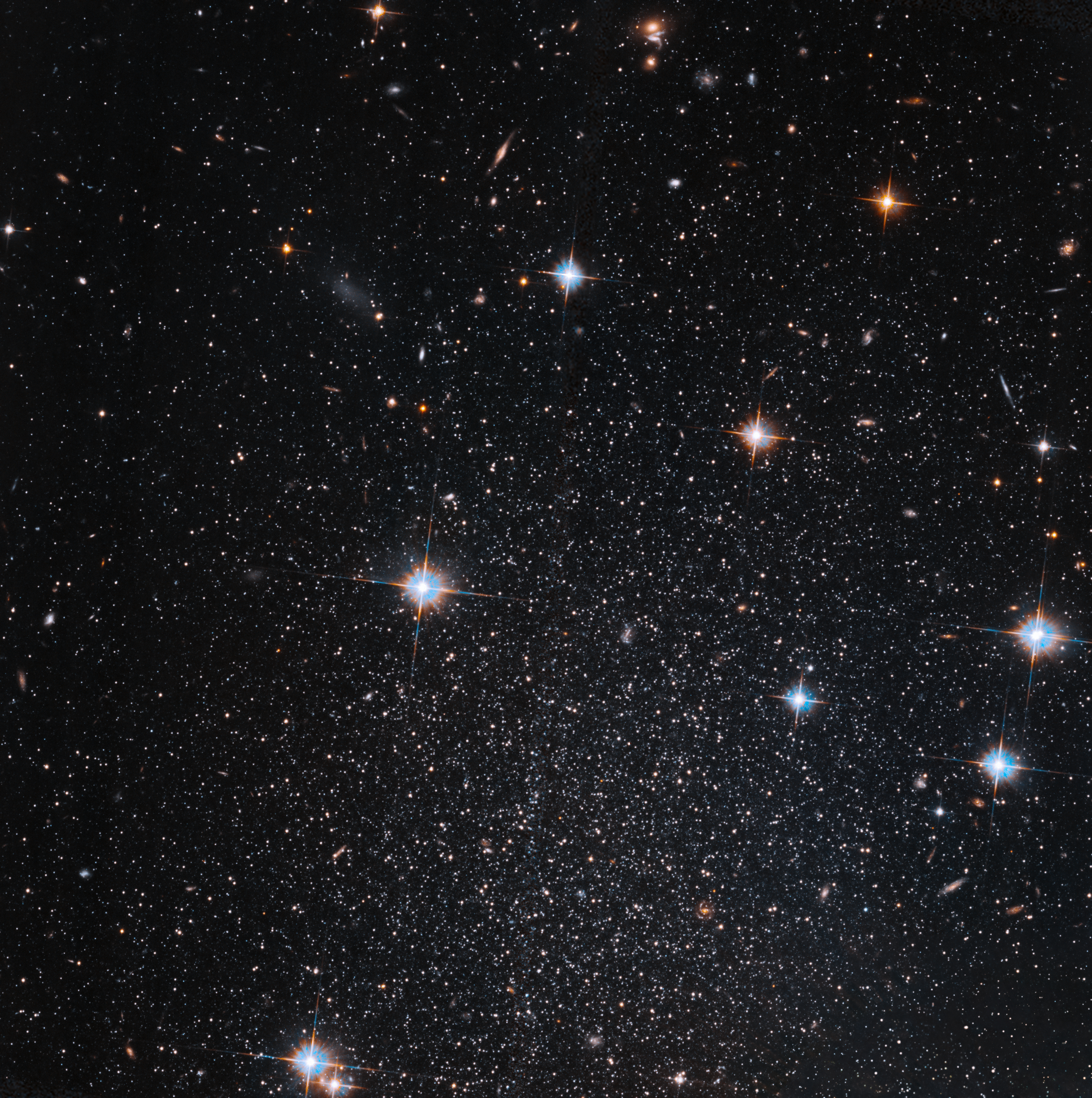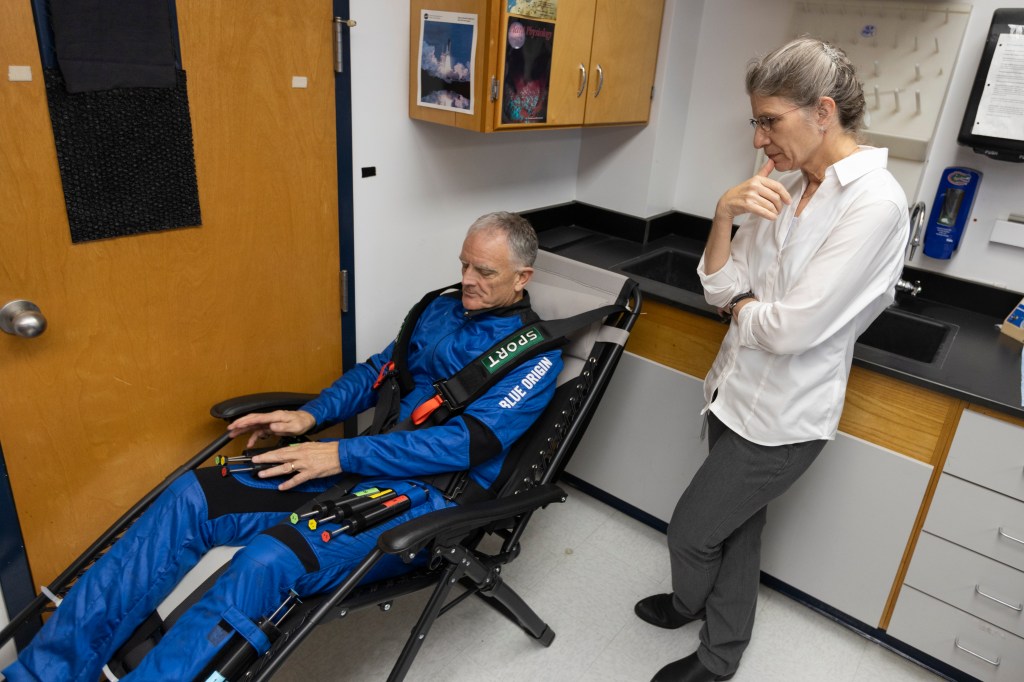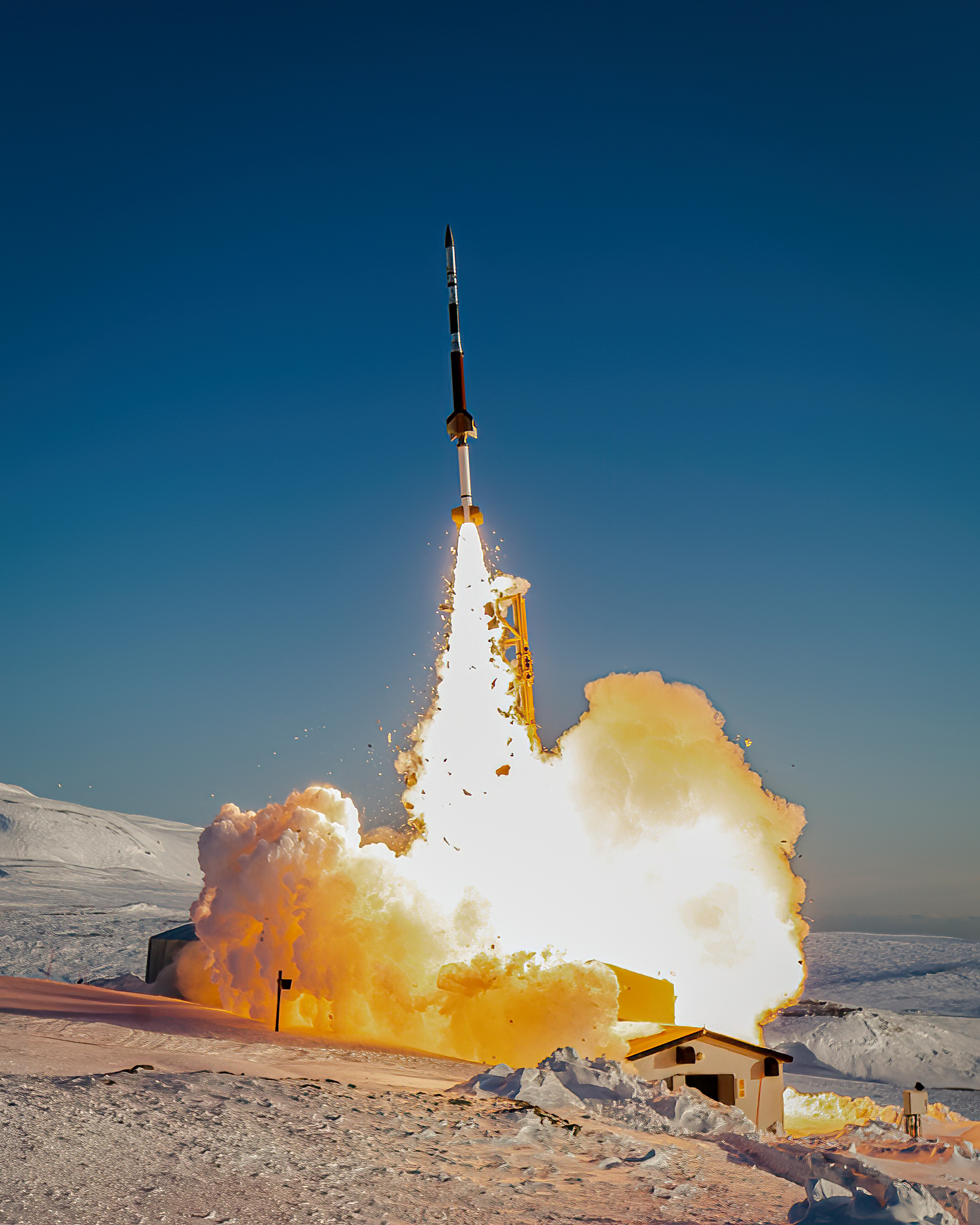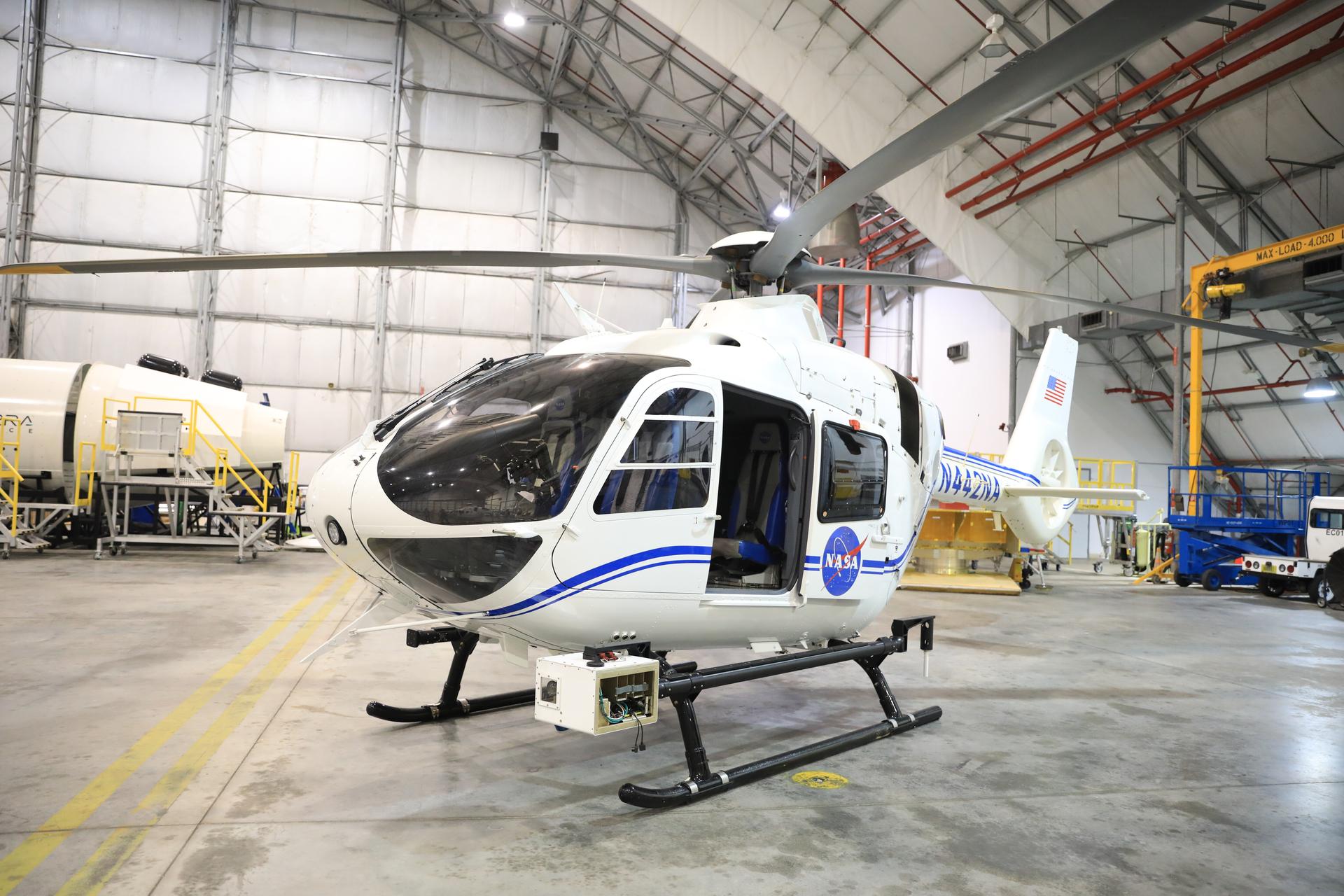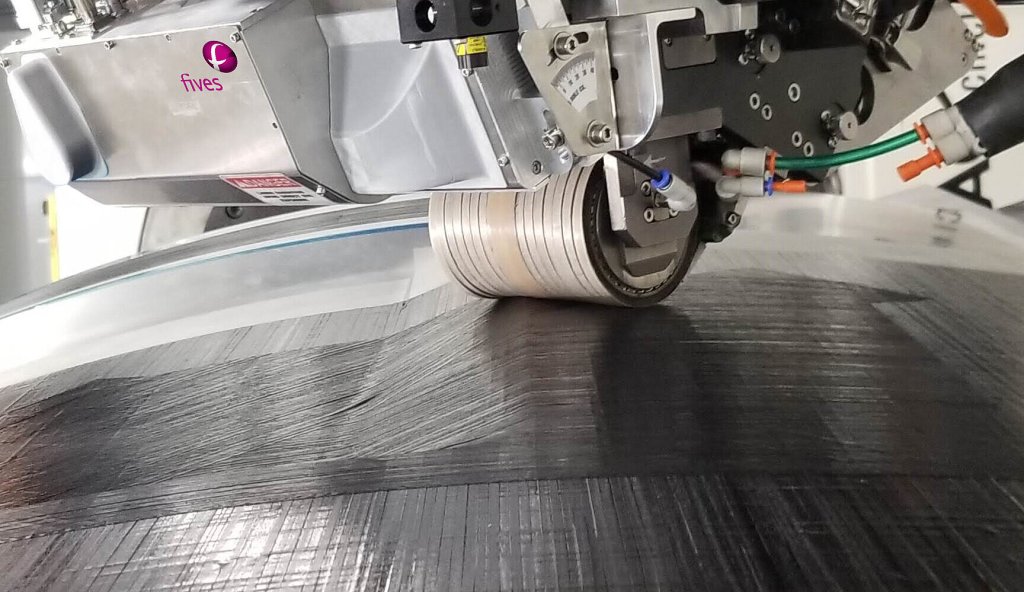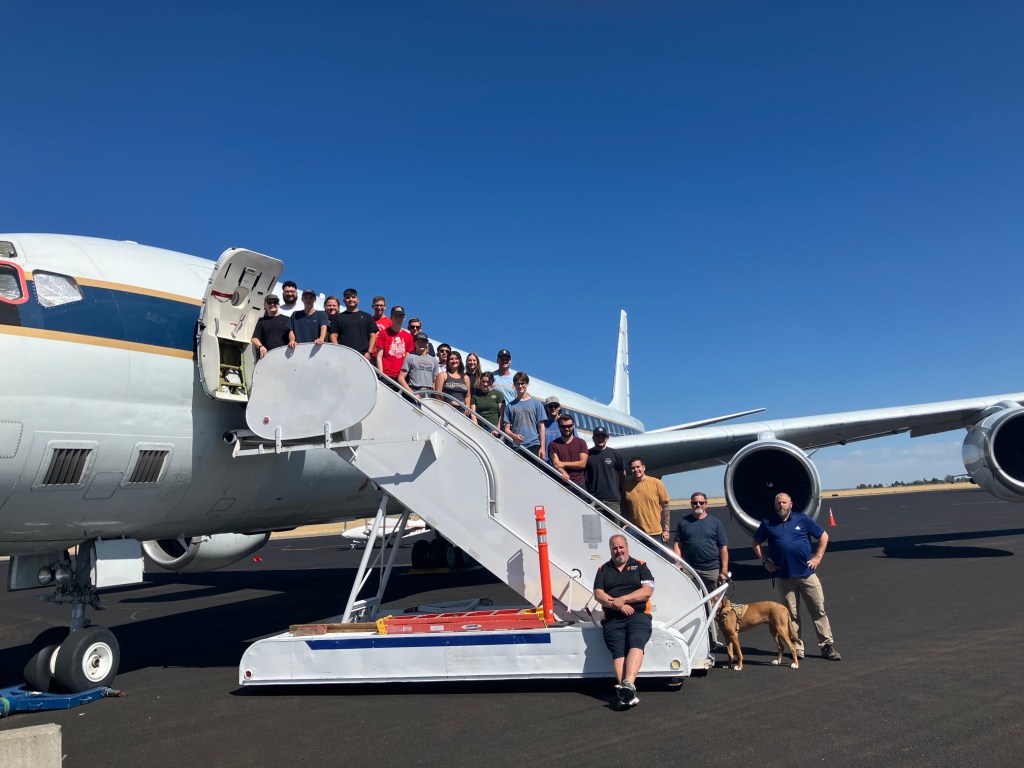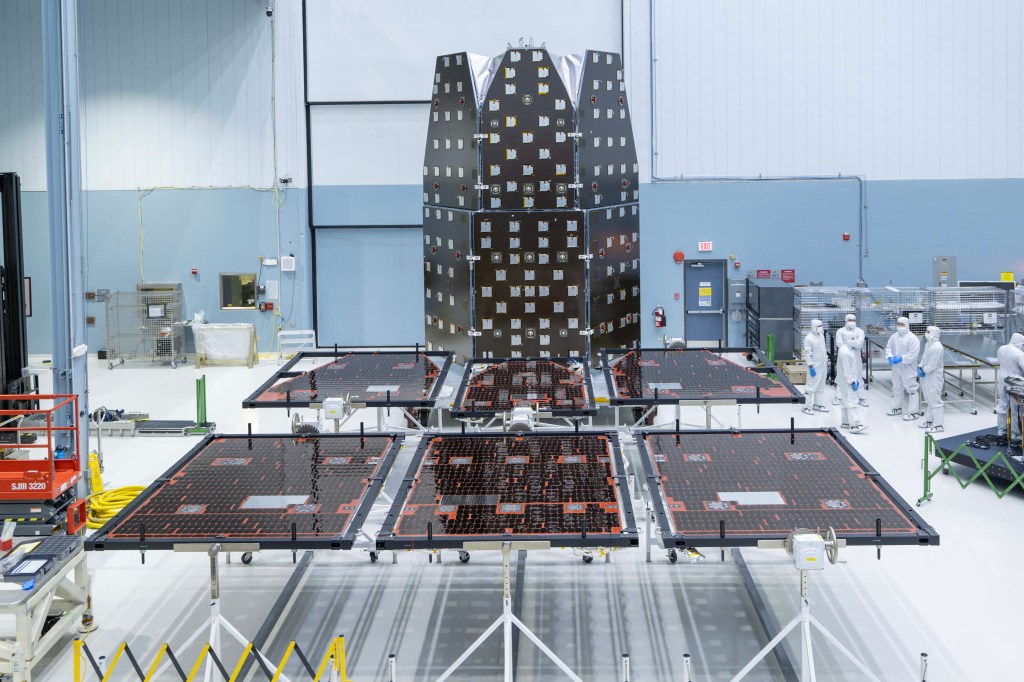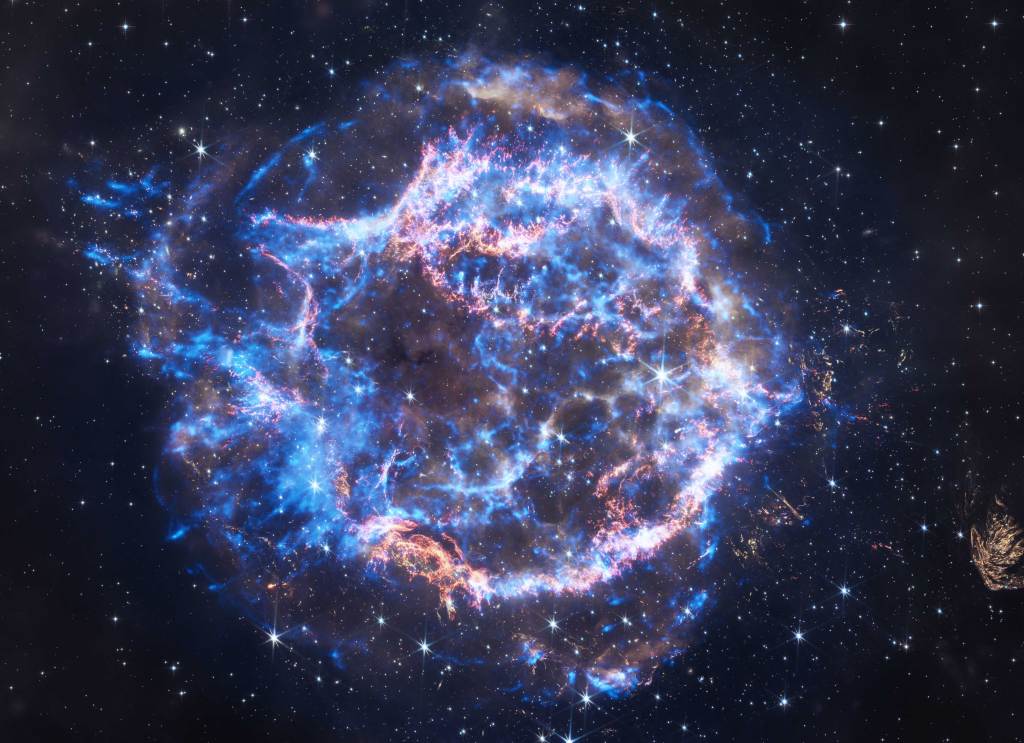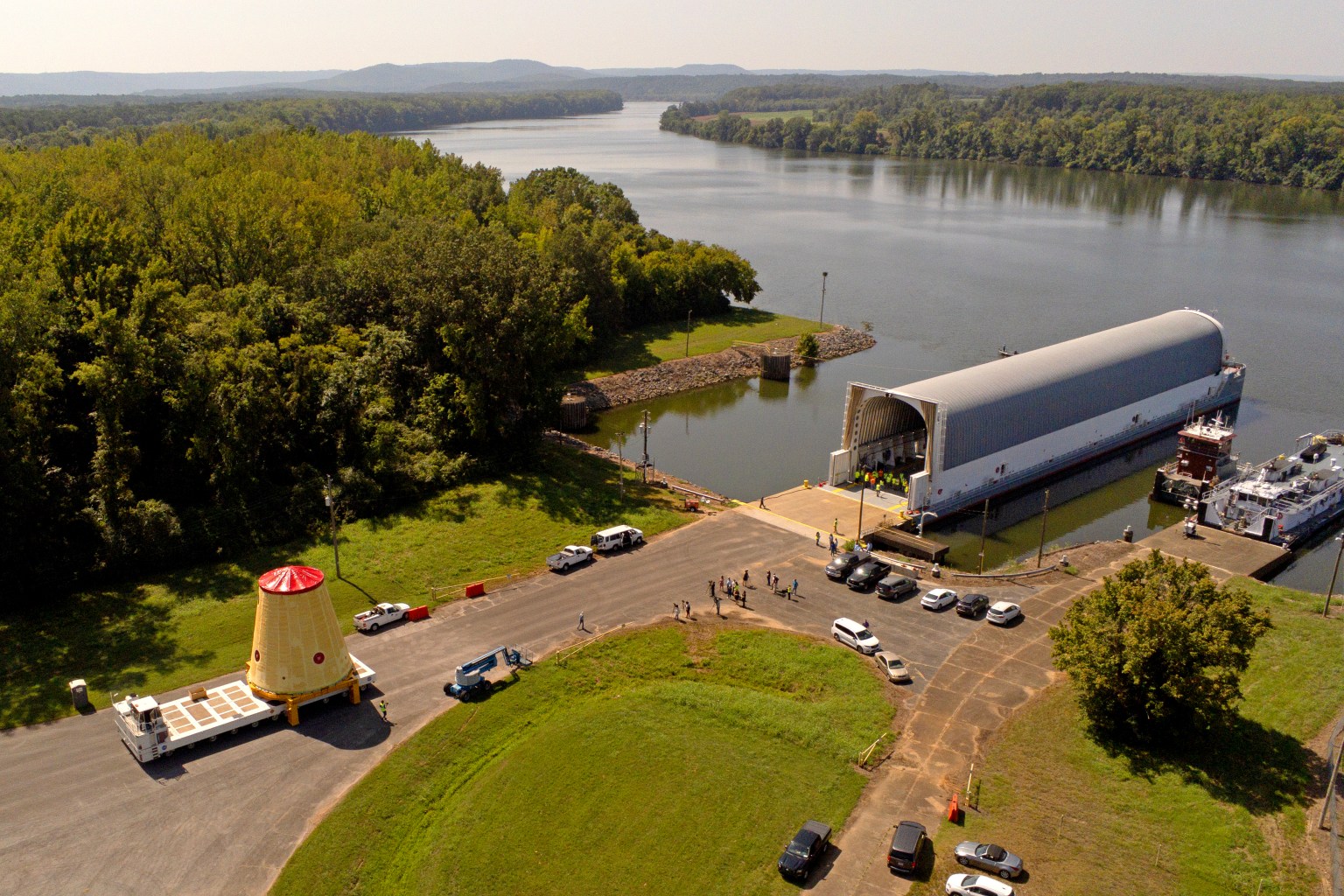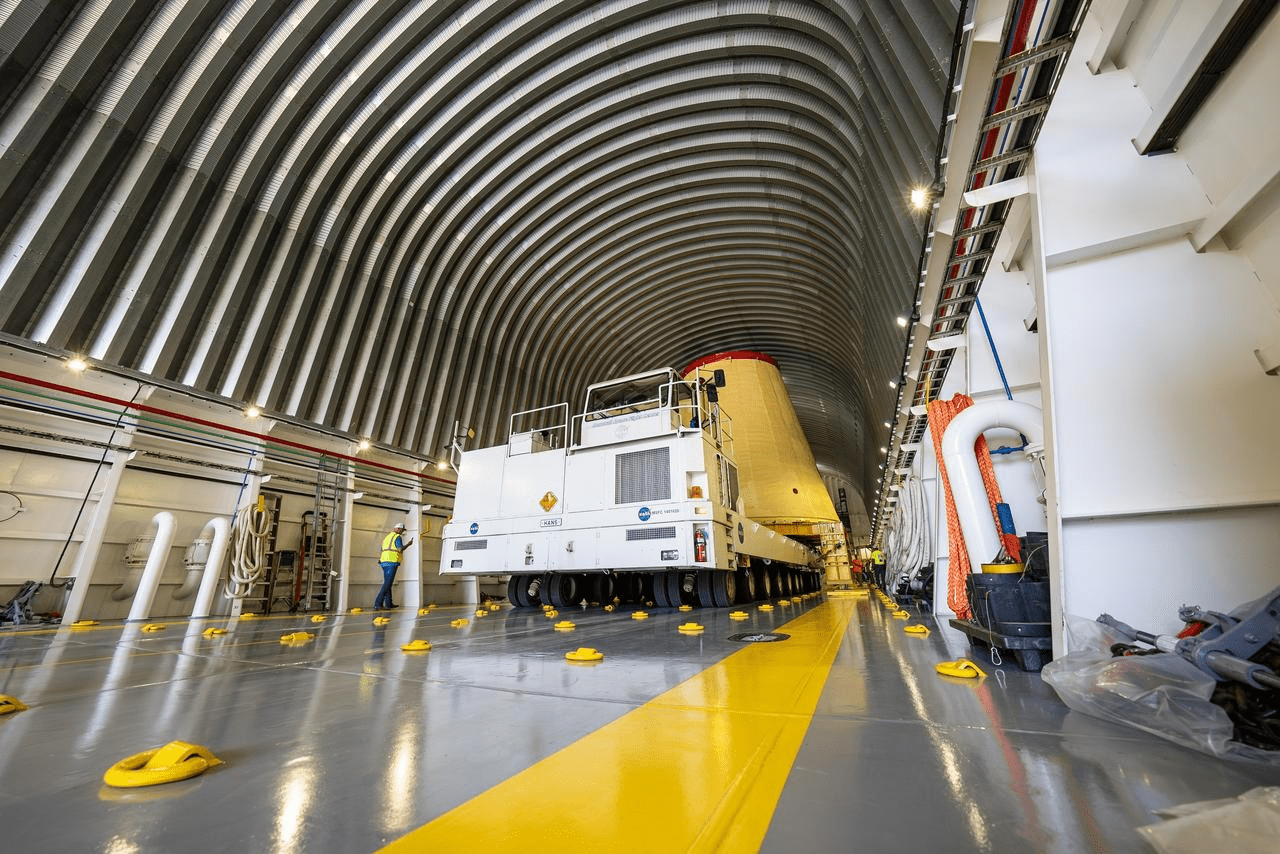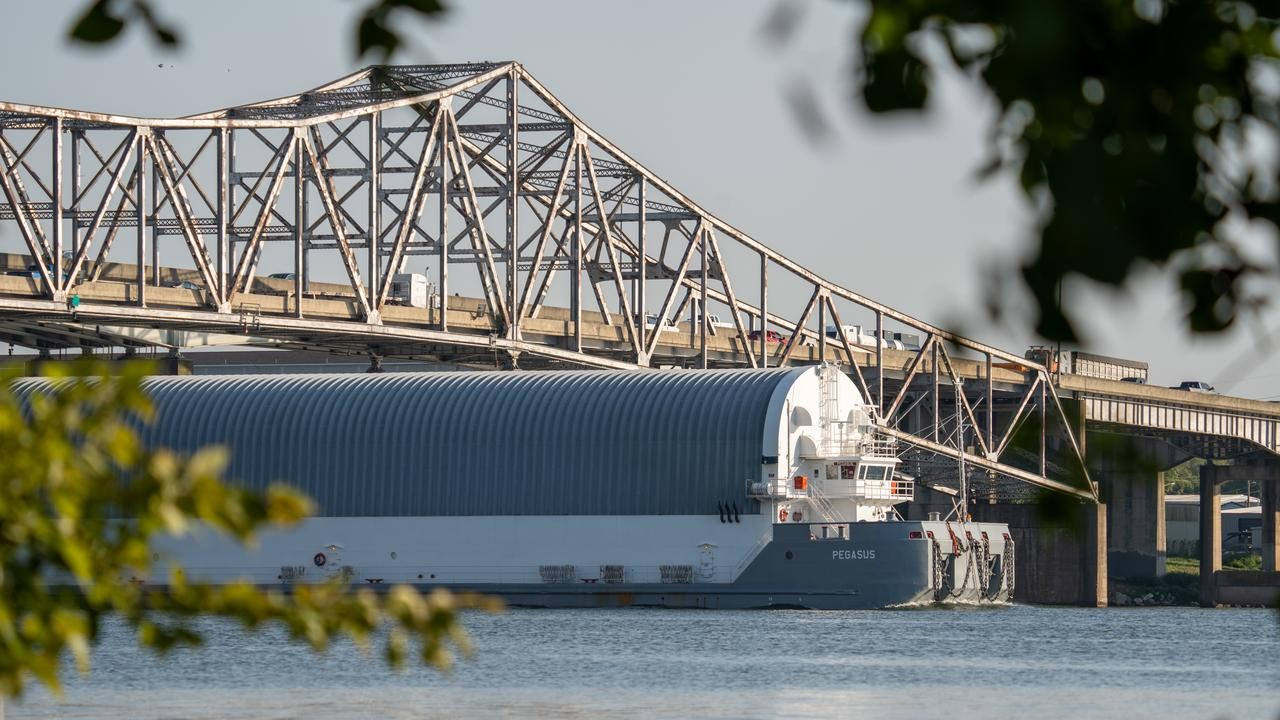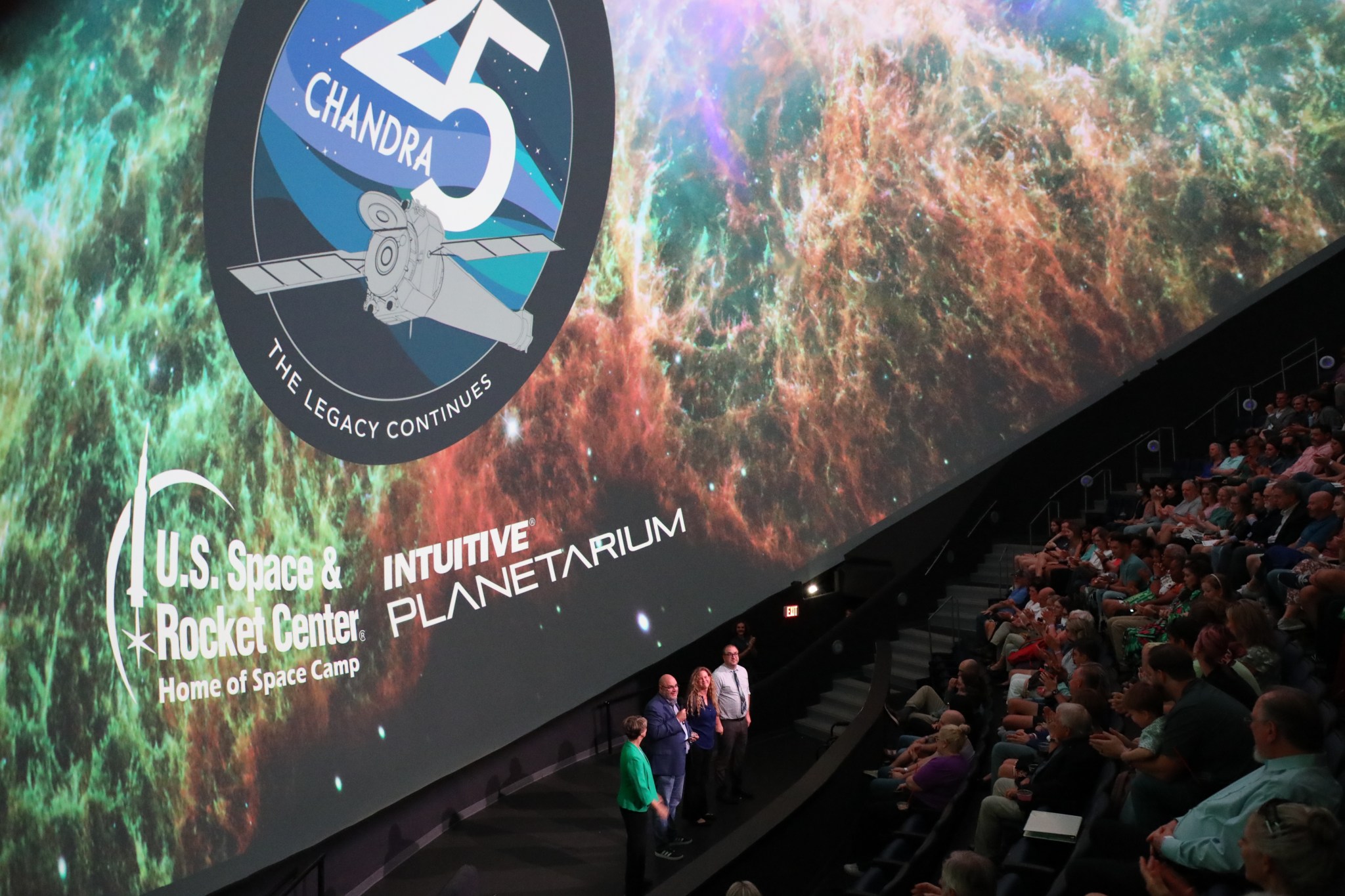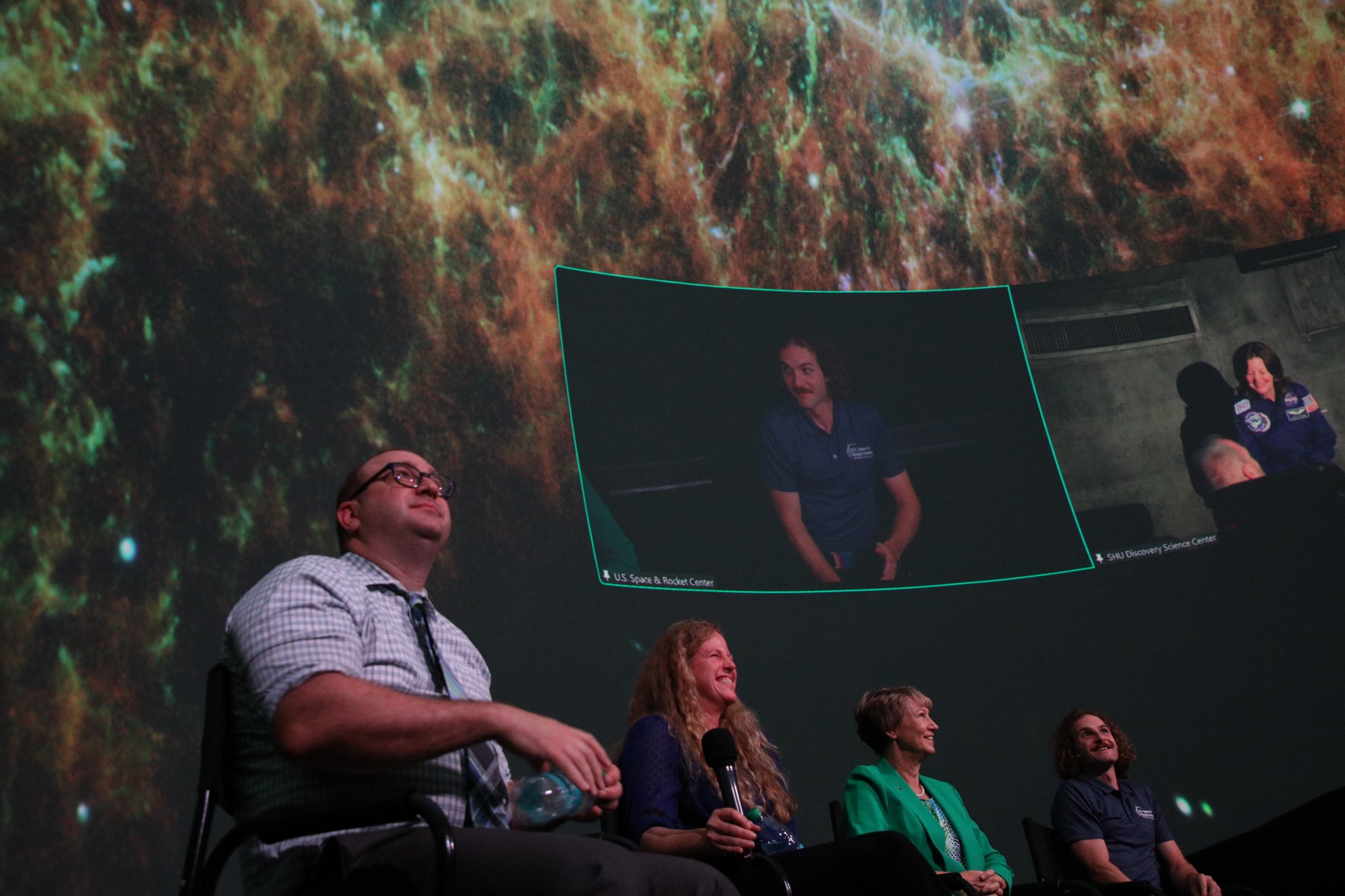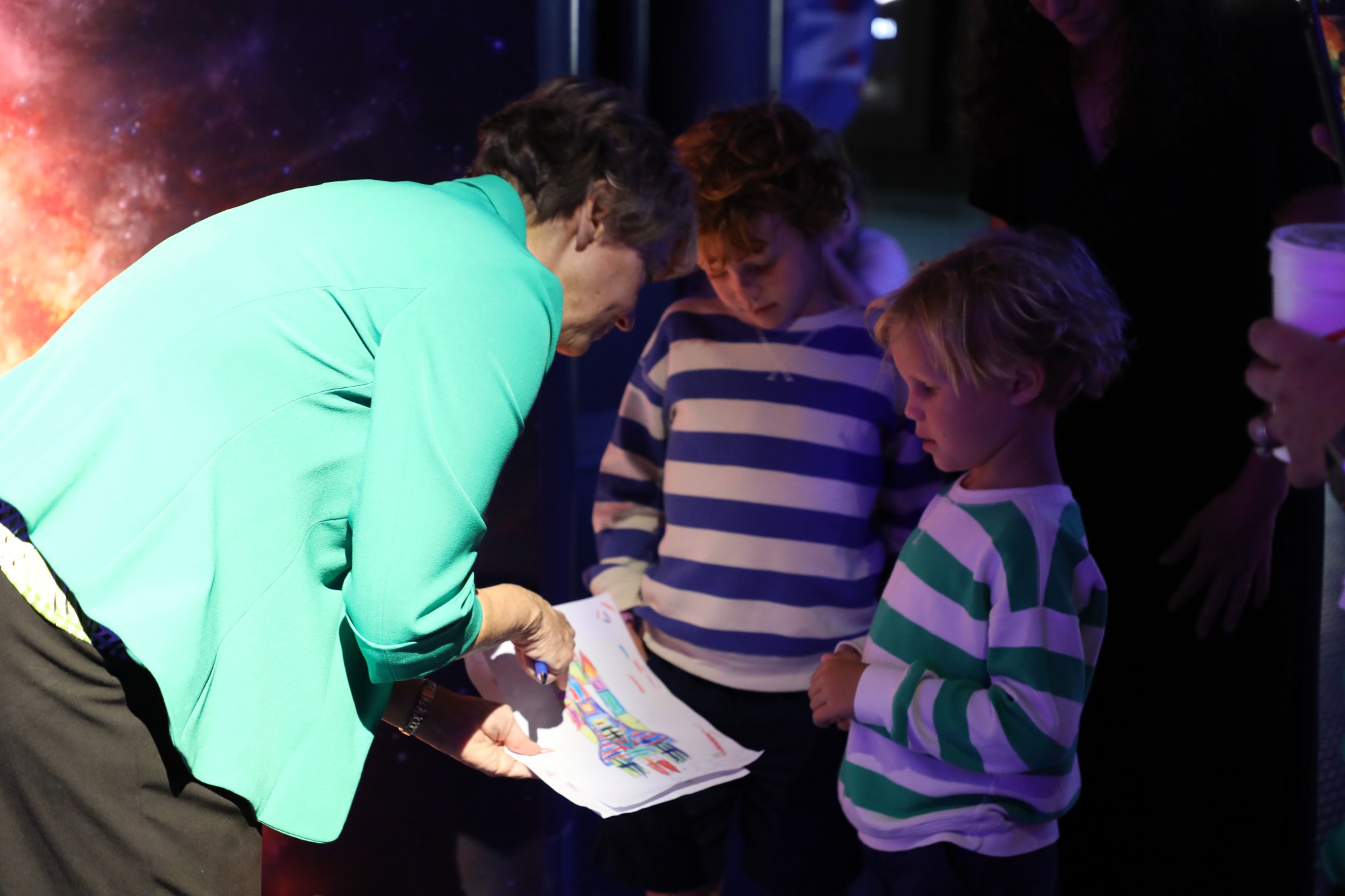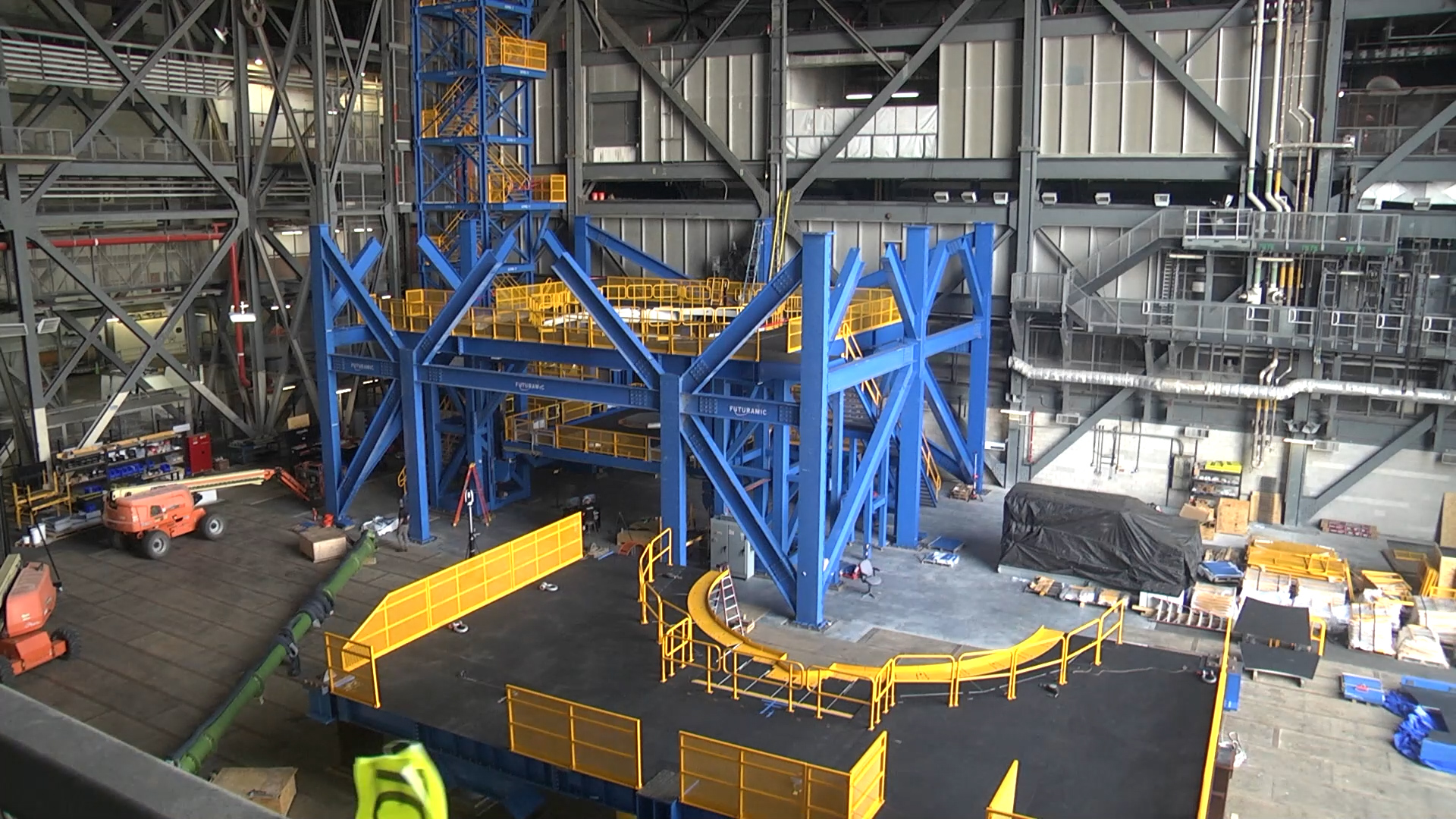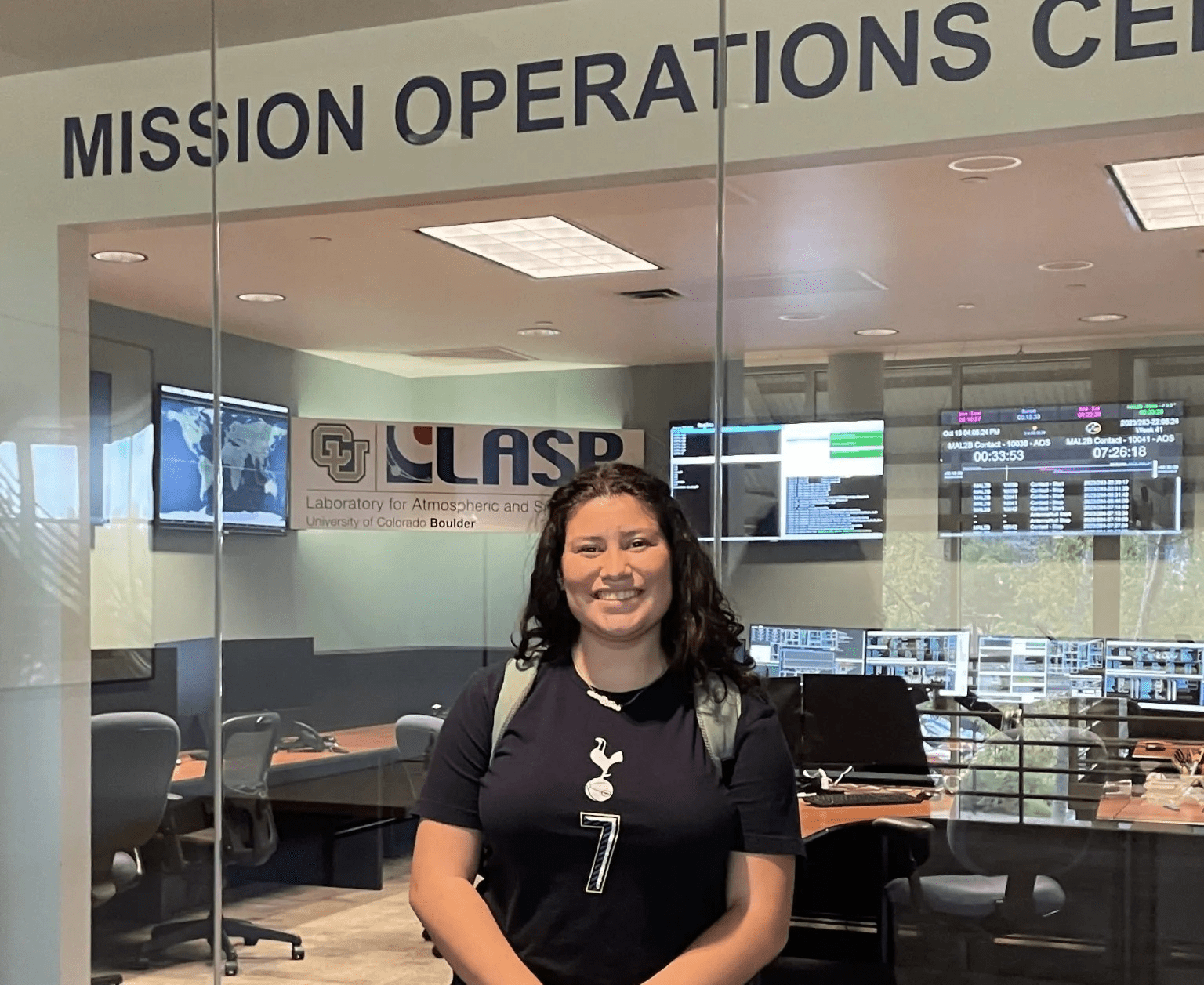Marshall Leadership Updates Team Members on Culture, Strategy
By Wayne Smith
Leadership from NASA’s Marshall Space Flight Center highlighted a successful summer before looking ahead to the center’s culture and strategy during an all-hands meeting Aug. 27 in Building 4316.
Marshall Director Joseph Pelfrey recapped milestone events of the past few months, including new hardware for the Artemis II test flight. The launch vehicle stage adapter for the SLS (Space Launch System) rocket was rolled out Aug. 21 at Marshall and loaded on to the Pegasus barge. In July, the rocket’s core stage was shipped from NASA’s Michoud Assembly Facility to the agency’s Kennedy Space Center. The summer started with a NASA in the Park event in downtown Huntsville that attracted more than 14,000 people to learn more about Marshall’s work and is winding down with the continued celebration of the 25th anniversary of NASA’s Chandra X-ray Observatory.
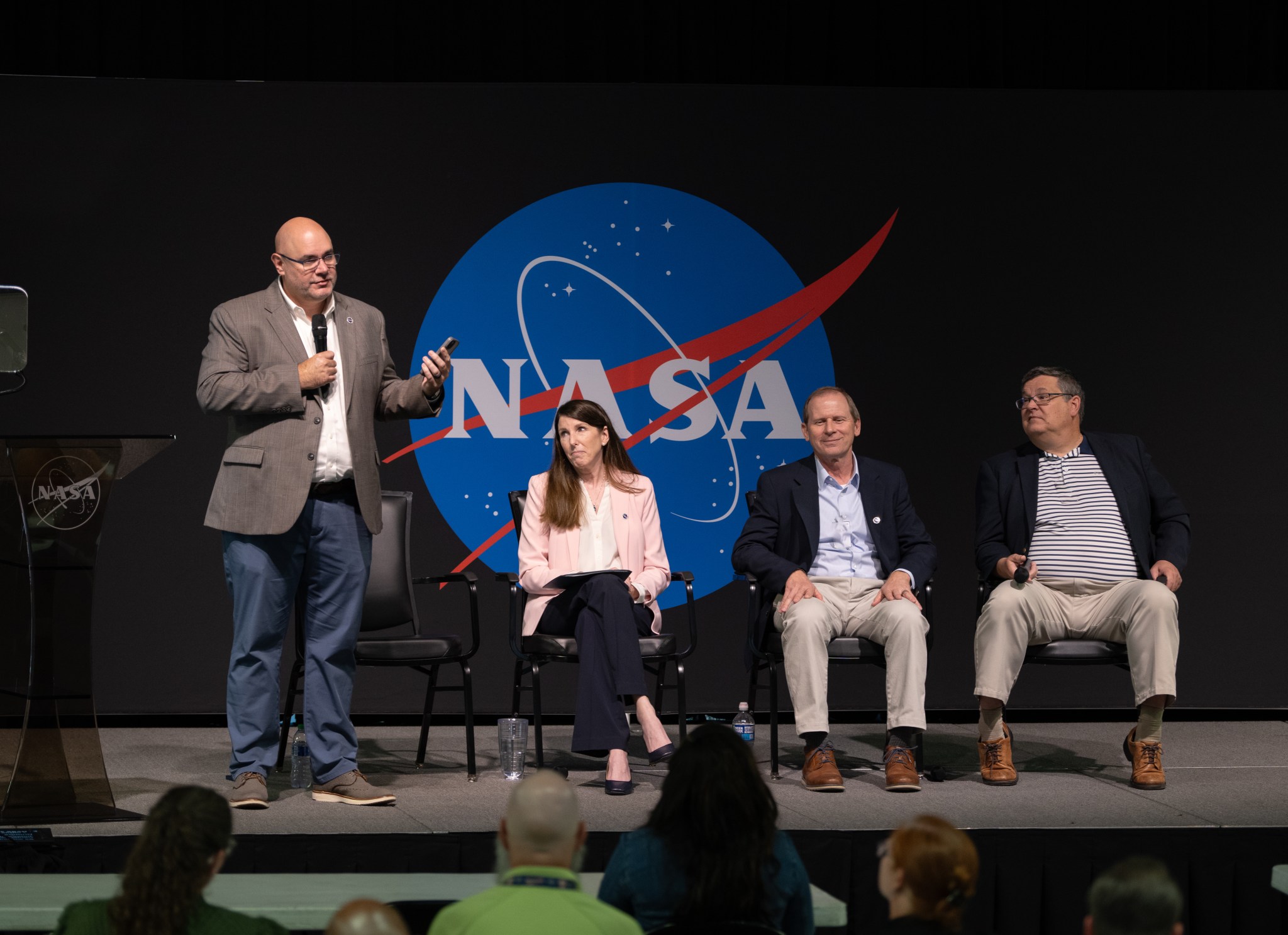
Pelfrey also commended Marshall’s Commercial Crew Program team members for their dedicated work and support of NASA’s Boeing Starliner Crew Flight Test to the International Space Station.
“I just really appreciate the teams that worked so hard between NASA and Boeing to evaluate issues, and the ultimate decision was about safety,” Pelfrey said. “Those teams did a lot of tremendous work on analysis and testing to bring data to decision makers. Now we will get to move forward.”
Before discussing Marshall’s culture and strategy, Pelfrey introduced three new members of Marshall’s leadership team: Davey Jones, center strategy lead; Denise Smithers, center executive officer; and Roger Baird, associate director.
Pelfrey said leadership recognizes the vital roles culture and strategy play in the center’s ongoing success as Marshall makes a transformative shift to more strategic partnerships across NASA and with industry. He pointed to activities like NASA 2040 and More to Marshall as the center heads toward its 65th anniversary next summer.
“Embracing a supportive work culture enhances collaboration, improves communication, and builds a sense of belonging and purpose,” Pelfrey said. “The center’s leadership team wants culture to come from all of us, so we continue to create opportunities for you to get involved, hear your feedback, and help shape the culture at Marshall.”
Rae Ann Meyer, the center’s deputy director, provided updates on Marshall’s culture initiatives. She invited team members to participate in a survey on the most important attributes for a thriving center, following up on feedback from last August. Meyer said leadership wants continued input from team members and applauded Marshall’s highest ever participation (85.1%) in the 2024 Federal Employee Viewpoint Survey.
“Regardless of role, each team member plays a vital part in shaping the culture that makes NASA and Marshall an extraordinary place to work and achieve great things,” Meyer said. “Creating a positive culture is a long-term process that requires time and sustained effort – it does not happen overnight.”
In his remarks, Jones also encouraged feedback and participation from team members. He said center culture and strategy “need to be attached at the hip.”
“Part of that success is making sure communication is open between center strategy and culture and to the workforce because it not only encourages collaboration, but also fosters transparency, which is one of the key cultural attributes discussed today,” Jones said.
Leadership took questions from team members to close out the session, before wrapping up with a More to Marshall video.
“This year, you have heard a lot about More to Marshall, and it is more than a slogan; it really symbolizes the initiative we have to prepare our center for the future and take advantage of all the expertise we have at the center and all our capabilities,” Pelfrey said. “It’s an approach that reinforces our center strategy that’s going to enable our future role in space exploration.”
Smith, a Media Fusion employee and the Marshall Star editor, supports the Marshall Office of Communications.
NASA Moves Artemis II Rocket Adapter to Pegasus Barge for Shipment
NASA rolled out a key piece of space flight hardware for the SLS (Space Launch System) rocket for the first crewed mission of NASA’s Artemis campaign from Marshall Space Flight Center on Aug. 21 for shipment to the agency’s Kennedy Space Center. The cone-shaped launch vehicle stage adapter connects the rocket’s core stage to the upper stage and helps protect the upper stage’s engine that will help propel the Artemis II test flight around the Moon, slated for 2025.
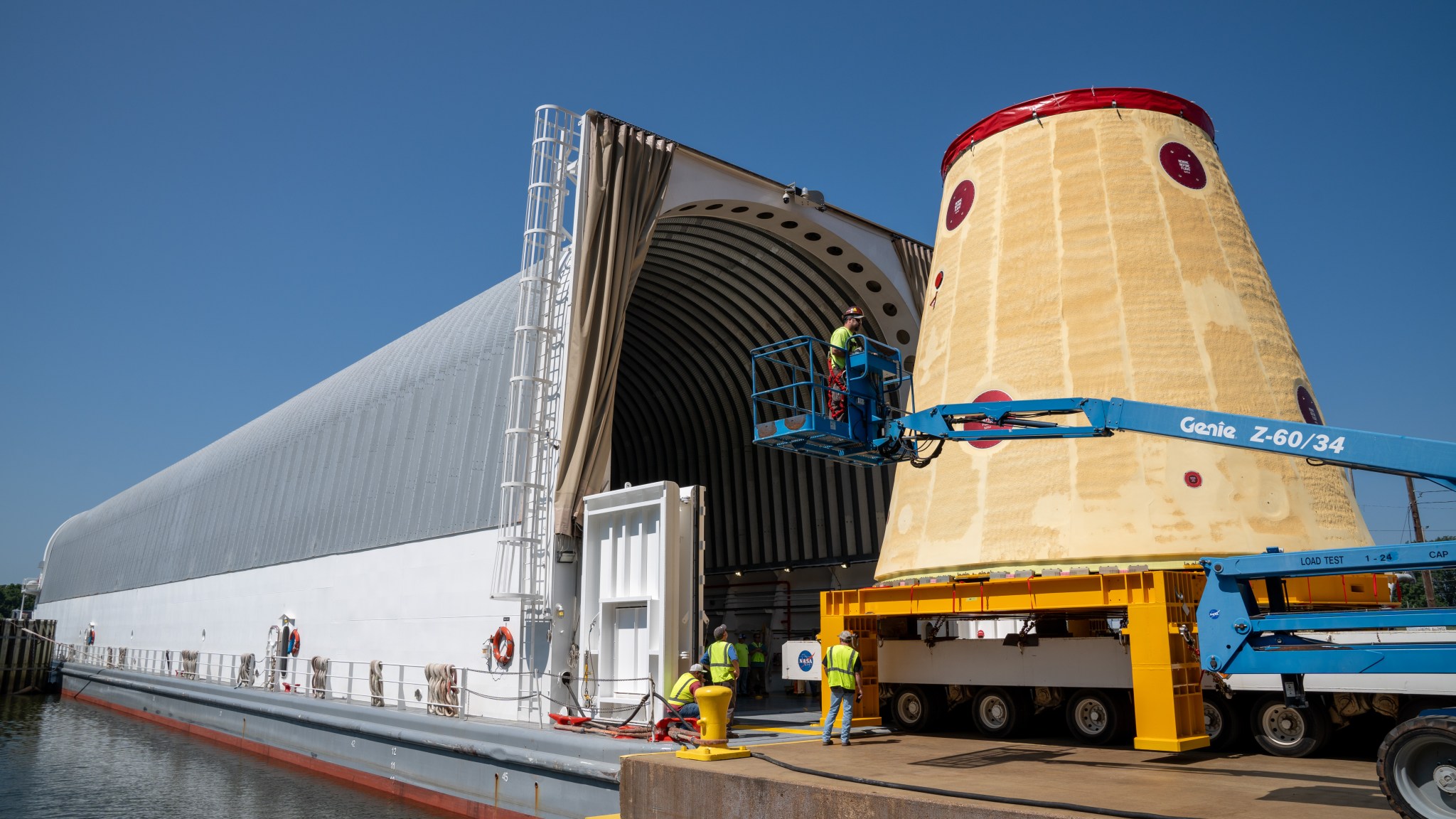
“The launch vehicle stage adapter is the largest SLS component for Artemis II that is made at the center,” said Chris Calfee, SLS Spacecraft Payload Integration and Evolution element manager. “Both the adapters for the SLS rocket that will power the Artemis II and Artemis III missions are fully produced at NASA Marshall. Alabama plays a key role in returning astronauts to the Moon.”
Crews moved the adapter out of Marshall’s Building 4708 to the agency’s Pegasus barge Aug. 21. The barge will ferry the adapter first to NASA’s Michoud Assembly Facility, where crews will pick up additional SLS hardware for future Artemis missions, before traveling to Kennedy. Once in Florida, the adapter will join the recently delivered core stage. There, teams with NASA’s Exploration Ground Systems will prepare the adapter for stacking and launch.

Engineering teams at Marshall are in the final phase of integration work on the launch vehicle stage adapter for Artemis III. The stage adapter is manufactured by prime contractor Teledyne Brown Engineering and the Jacobs Space Exploration Group’s ESSCA (Engineering Services and Science Capability Augmentation) contract using NASA Marshall’s self-reacting friction-stir robotic and vertical weld tools.
Through the Artemis campaign, NASA will land the first woman, first person of color, and its first international partner astronaut on the Moon. The rocket is part of NASA’s deep space exploration plans, along with the Orion spacecraft, supporting ground systems, advanced spacesuits and rovers, Gateway in orbit around the Moon, and commercial human landing systems. NASA’s SLS is the only rocket that can send Orion, astronauts, and supplies to the Moon in a single launch.
Cassiopeia A,Thenthe Cosmos: 25 Years of Chandra X-ray Science
By Rick Smith
On Aug. 26, 1999, NASA’s Chandra X-ray Observatory opened its powerful telescopic eye in orbit and captured its awe-inspiring “first light” images of Cassiopeia A, a supernova remnant roughly 11,000 light-years from Earth. That first observation was far more detailed than anything seen by previous X-ray telescopes, even revealing – for the first time ever – a neutron star left in the wake of the colossal stellar detonation.

Those revelations came as no surprise to Chandra project scientist Martin Weisskopf, who led Chandra’s development at NASA’s Marshall Space Flight Center. “When you build instrumentation that’s 10 times more sensitive than anything that was done before, you’re bound to discover something new and exciting,” he said. “Every step forward was a giant step forward.”
Twenty-five years later, Chandra has repeated that seminal moment of discovery again and again, delivering – to date – nearly 25,000 detailed observations of neutron stars, quasars, supernova remnants, black holes, galaxy clusters, and other highly energetic objects and events, some as far away as 13 billion light-years from Earth.
Chandra has further helped scientists gain tangible evidence of dark matter and dark energy, documented the first electromagnetic events tied to gravitational waves in space, and most recently aided the search for habitable exoplanets – all vital tools for understanding the vast, interrelated mechanisms of the universe we live in.
“Chandra’s first image of Cas A provided stunning demonstration of Chandra’s exquisite X-ray mirrors, but it simultaneously revealed things we had not known about young supernova remnants,” said Pat Slane, director of the CXC (Chandra X-ray Center) housed at the Smithsonian Astrophysical Observatory in Cambridge, Massachusetts. “In a blink, Chandra not only revealed the neutron star in Cas A; it also taught us that young neutron stars can be significantly more modest in their output than what previously had been understood. Throughout its 25 years in space, Chandra has deepened our understanding of fundamental astrophysics, while also greatly broadening our view of the universe.”
To mark Chandra’s silver anniversary, NASA and CXC have shared 25 of its most breathtaking images and debuted a new video, “Eye on the Cosmos.”
Chandra often is used in conjunction with other space telescopes that observe the cosmos in different parts of the electromagnetic spectrum, and with other high-energy missions such as ESA’s (European Space Agency’s) XMM-Newton; NASA’s Swift, NuSTAR (Nuclear Spectroscopic Telescope Array), and IXPE (Imaging X-ray Polarization Explorer) imagers, and NASA’s NICER (Neutron Star Interior Composition Explorer) X-ray observatory, which studies high-energy phenomena from its vantage point aboard the International Space Station.
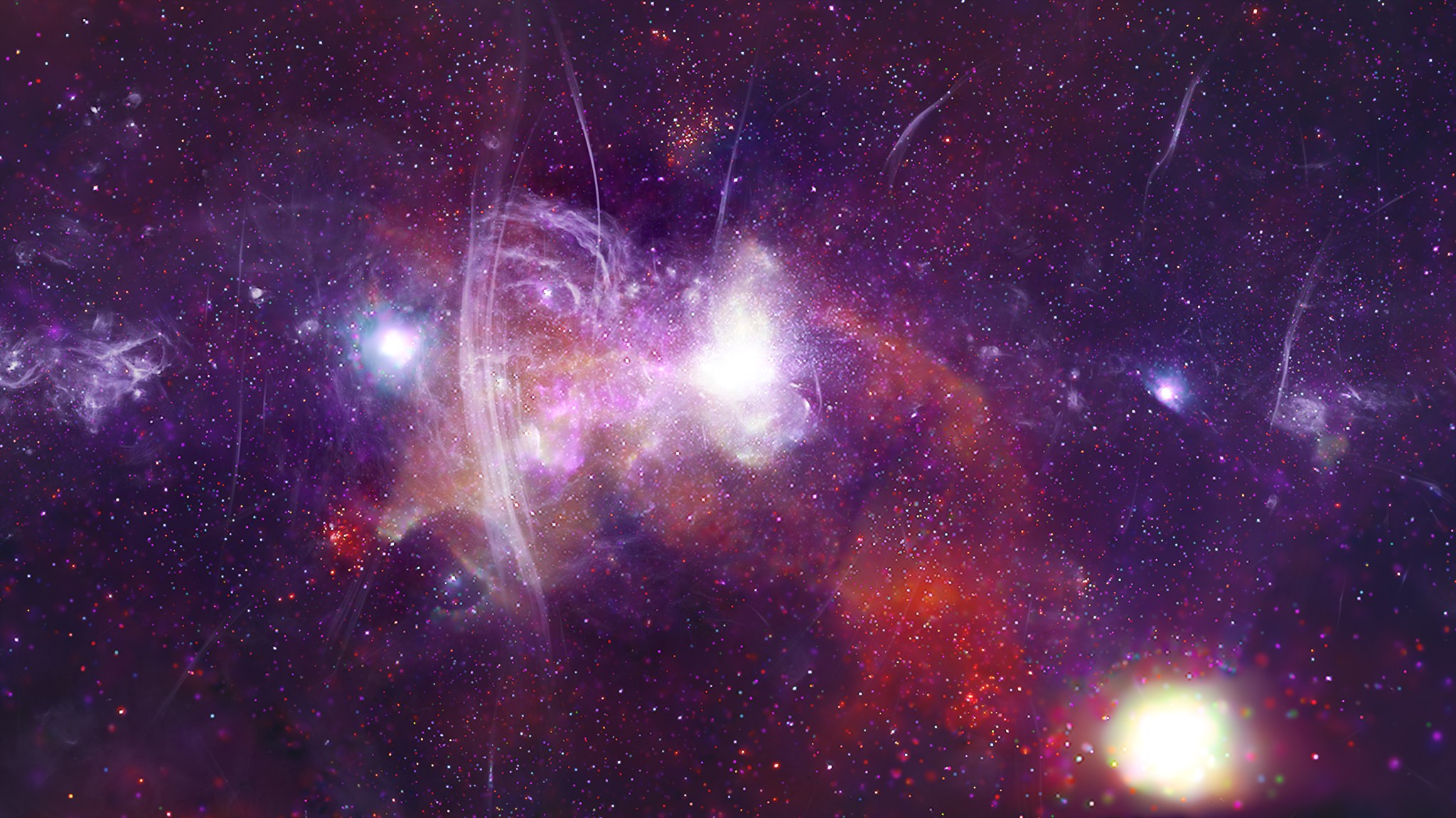
Chandra remains a unique, global science resource, with a robust data archive that will continue to serve the science community for many years.
“NASA’s project science team has always strived to conduct Chandra science as equitably as possible by having the world science community collectively decide how best to use the observatory’s many tremendous capabilities,” said Douglas Swartz, a USRA (Universities Space Research Association) principal research scientist on the Chandra project science team.
“Chandra will continue to serve the astrophysics community long after its mission ends,” said Andrew Schnell, acting Chandra program manager at Marshall. “Perhaps its greatest discovery hasn’t been discovered yet. It’s just sitting there in our data archive, waiting for someone to ask the right question and use the data to answer it. It could be somebody who hasn’t even been born yet.”
That archive is impressive indeed. To date, Chandra has delivered more than 70 trillion bytes of raw data. More than 5,000 unique principal investigators and some 3,500 undergraduate and graduate students around the world have conducted research based on Chandra’s observations. Its findings have helped earn more than 700 PhDs and resulted in more than 11,000 published papers, with half a million total citations.
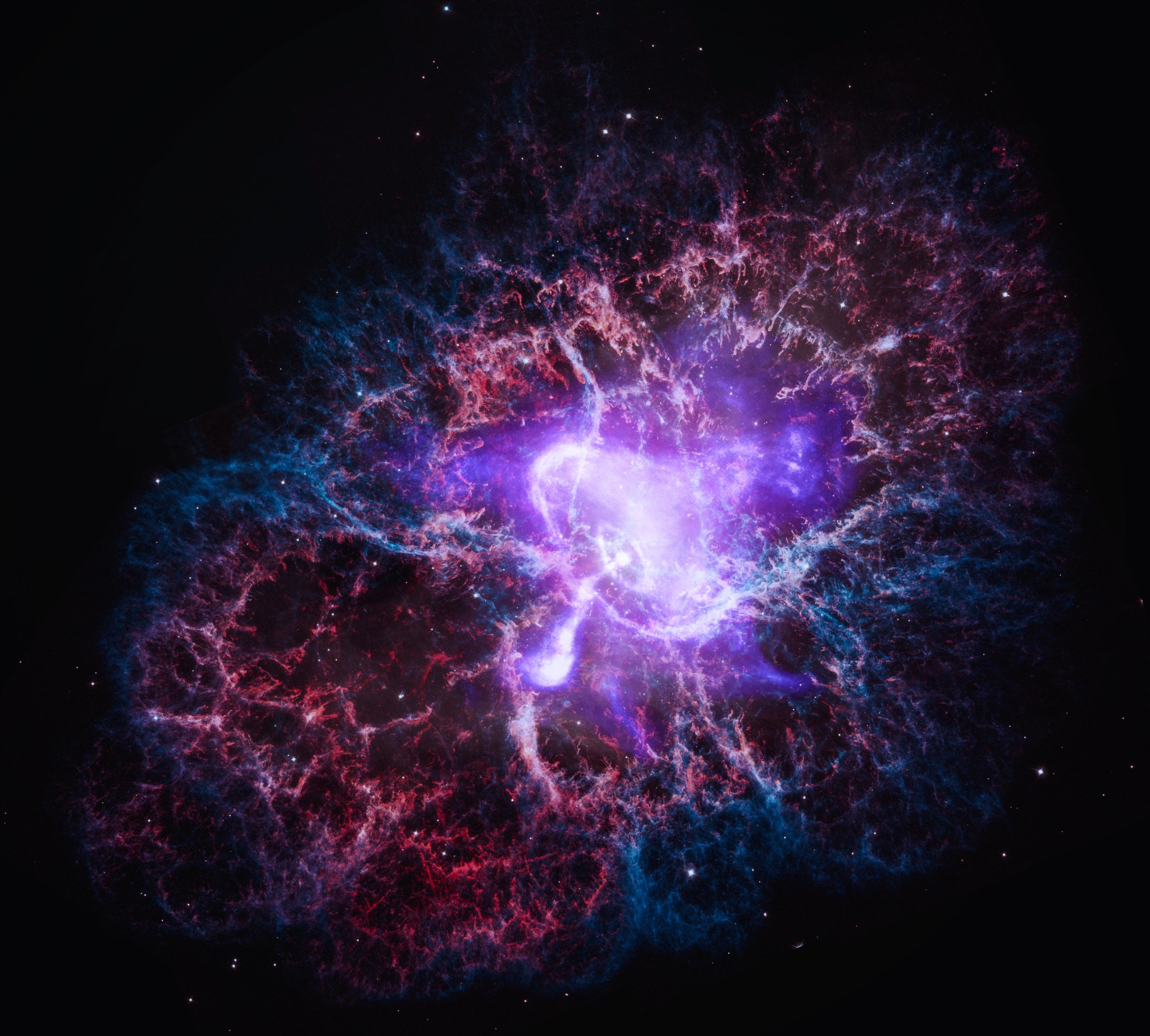
Weisskopf is now an emeritus researcher who still keeps office hours every weekday despite having retired from NASA in 2022. He said the work remains as stimulating now as it was 25 years ago, waiting breathlessly for those “first light” images.
“We’re always trying to put ourselves out of business with the next bit of scientific understanding,” he said. “But these amazing discoveries have demonstrated how much NASA’s astrophysics missions still have to teach us.”
The universe keeps turning – and Chandra’s watchful eye endures.
Chandra, managed for NASA by Marshall in partnership with the CXC, is one of NASA’s Great Observatories, along with the Hubble Space Telescope and the now-retired Spitzer Space Telescope and Compton Gamma Ray Observatory. It was first proposed to NASA in 1976 by Riccardo Giacconi, recipient of the 2002 Nobel Prize for Physics based on his contributions to X-ray astronomy, and Harvey Tananbaum, who would later become the first director of the Chandra X-ray Center. Chandra was named in honor of the late Nobel laureate Subrahmanyan Chandrasekhar, who earned the Nobel Prize in Physics in 1983 for his work explaining the structure and evolution of stars.
Smith, an Aeyon/MTS employee, supports the Marshall Office of Communications.
The Legacy Continues: Space & Rocket Center Event Highlights Chandra’s 25th Anniversary
NASA Marshall Space Flight Center Director Joseph Pelfrey, bottom center, second from left, welcomes Huntsville community members to an event celebrating 25 years of the agency’s Chandra X-ray Observatory at the U.S. Space & Rocket Center’s Intuitive Planetarium on Aug. 23. Pelfrey introduced the evening’s panelists, which included, from left, former NASA astronaut Eileen Collins, Marshall research astrophysicist Jessica Gaskin, and Chandra deputy project scientist Steven Ehlert. Pelfrey also introduced the premier showing of a video marking Chandra’s 25th anniversary. (NASA/Taylor Goodwin)
The program was hosted by David Weigel, bottom right, director of the U.S. Space & Rocket Center’s Intuitive Planetarium. Former NASA astronaut Cady Coleman, top right, joined the panel virtually to share her experience as a mission specialist on STS-93, which deployed the iconic space telescope. Collins joined STS-93 as the first woman to command a space shuttle mission. Together, the two former astronauts gave first-hand accounts of their journey aboard space shuttle Columbia. (NASA/Taylor Goodwin)
Collins shared her enthusiasm for space exploration and the importance of Chandra’s scientific contributions to attendees of all ages throughout the event. (NASA/Taylor Goodwin)
Take 5 with April Hargrave
By Wayne Smith
April Hargrave’s father was an educator who encouraged her from an early age to believe she could be whatever she wanted to be.
She followed her father’s guidance.
Today, Hargrave is the manager of Program, Planning, and Control (PP&C) in the Human Exploration Development and Operations (HP/HEDO) Office at NASA’s Marshall Space Flight Center. Hargrave credits her parents for inspiring her to seek a career that eventually led to Marshall, where she has been for 15 years.
Hargrave’s father – G.W. Braidfoot – was a high school educator in Lawrence County, Alabama, for 28 years. He taught history and civics, before moving into roles as an administrator and guidance counselor, focusing on guiding his students toward their post-high school goals.
“What has always stood out to me is my parents never placed boundaries on my passions and career choices,” said Hargrave, a North Alabama native who lives in Athens. “Reflecting back, that is something of which I am very appreciative. In the absence of boundaries, it has allowed me to push myself in my pursuits and shaped my career path, which included high school STEM courses and college career choices.
Those college choices were pursuing a bachelor’s degree in chemistry at the University of North Alabama in Florence, and later another degree in chemical engineering at the University of Alabama in Huntsville.
As PP&C manager for HEDO’s diverse and complex portfolio of programs, projects, and other activities, Hargrave provides tools and resources to HP management that enables strategic decision making and workforce planning.
“My background and experiences helped shaped my early career in industry and established a strong foundation and relationships, which led me to Marshall mid-career,” she said. “At Marshall, I’m thankful to have had mentors and encouragers who have led me to my current leadership role – people who believed in me and allowed me an opportunity. For that, I will forever be grateful.”
Question: What excites you most about the future of human space exploration, or your NASA work, and your team’s role it?
Hargrave: What excites me the most are the advancements we are making in human health and exploration. I’ve had close relatives suffer from diseases, such as Alzheimer’s and heart disease. I hope to see in the near future outcomes of human research on the International Space Station and the Moon that leads to medical and technology advancements, resulting in slowing the progression and eventually eliminating these diseases. Our HP PP&C team enables our missions by providing planning, integration, and support across our organization.
Question: What has been the proudest moment of your career and why?
Hargrave: Being able to mentor others throughout my career and watching them achieve success. Being in a position to recognize potential in others and encourage them to stretch and take risks in their careers, I find it very rewarding, especially after they have moved on that I’m able to still observe the growth and development they’ve experienced and to know I made a contribution.
Question: Who or what drives/motivates you?
Hargrave: My team drives me – I have a wonderful team that motivates me to be the best version of myself I can be. My team is comprised of a diverse group of personnel whose jobs are not always connected. However, we are still able to promote a great teaming environment where we encourage and leverage off each other’s skills and knowledge bases. My team is dedicated to doing the best job possible which motivates me daily in the excellent support they provide across HP. It allows me opportunities to lead by example and recognize their successes. It also allows me to look across the team and how to use them best based on their strengths.
Question: What advice do you have for employees early in their NASA career or those in new leadership roles?
Hargrave: It is important to learn what the NASA mission is and don’t be afraid to ask questions. Learn about the work that you are doing and how it impacts the mission as a whole. As you learn and understand the work within your role, develop a passion for the work. Take opportunities to understand the big picture and learn what others are doing across the center. Don’t be afraid to take lateral opportunities to allow you to gain new experiences and broaden your knowledge base. And if you find yourself in a leadership role, never lose sight that it’s the people behind that work that’s most important. Take the time to build and nurture those relationships because at the end of the day, our workforce is what makes us successful.
Question: What do you enjoy doing with your time while away from work?
Hargrave: My joy is helping and supporting others. Being part of a large family (raised one of five children and an even larger extended family), there’s naturally always plenty to do and lots of family to help and encourage. Much of my recent years have been spent cheering on my sons, nieces, and nephews. I also enjoy serving in my church and helping organize events to celebrate our family and friends.
Smith, a Media Fusion employee and the Marshall Star editor, supports the Marshall Office of Communications.
Over the Moon: Photographer Captures Supermoon Rising Near Marshall
By Wayne Smith
Once in a Blue Moon wasn’t enough for Michael DeMocker, a photographer for NASA’s Michoud Assembly Facility.
Nearly one year after capturing a spectacular image of a super Blue Moon rising over the Crescent City Connection Bridge in New Orleans, DeMocker found another opportunity to focus his camera on the lunar landscape while visiting the Rocket City. The result was another stunning photograph, this one of the Moon rising Aug. 19 behind the Saturn V rocket at the U.S. Space & Rocket Center in Huntsville, near NASA’s Marshall Space Flight Center
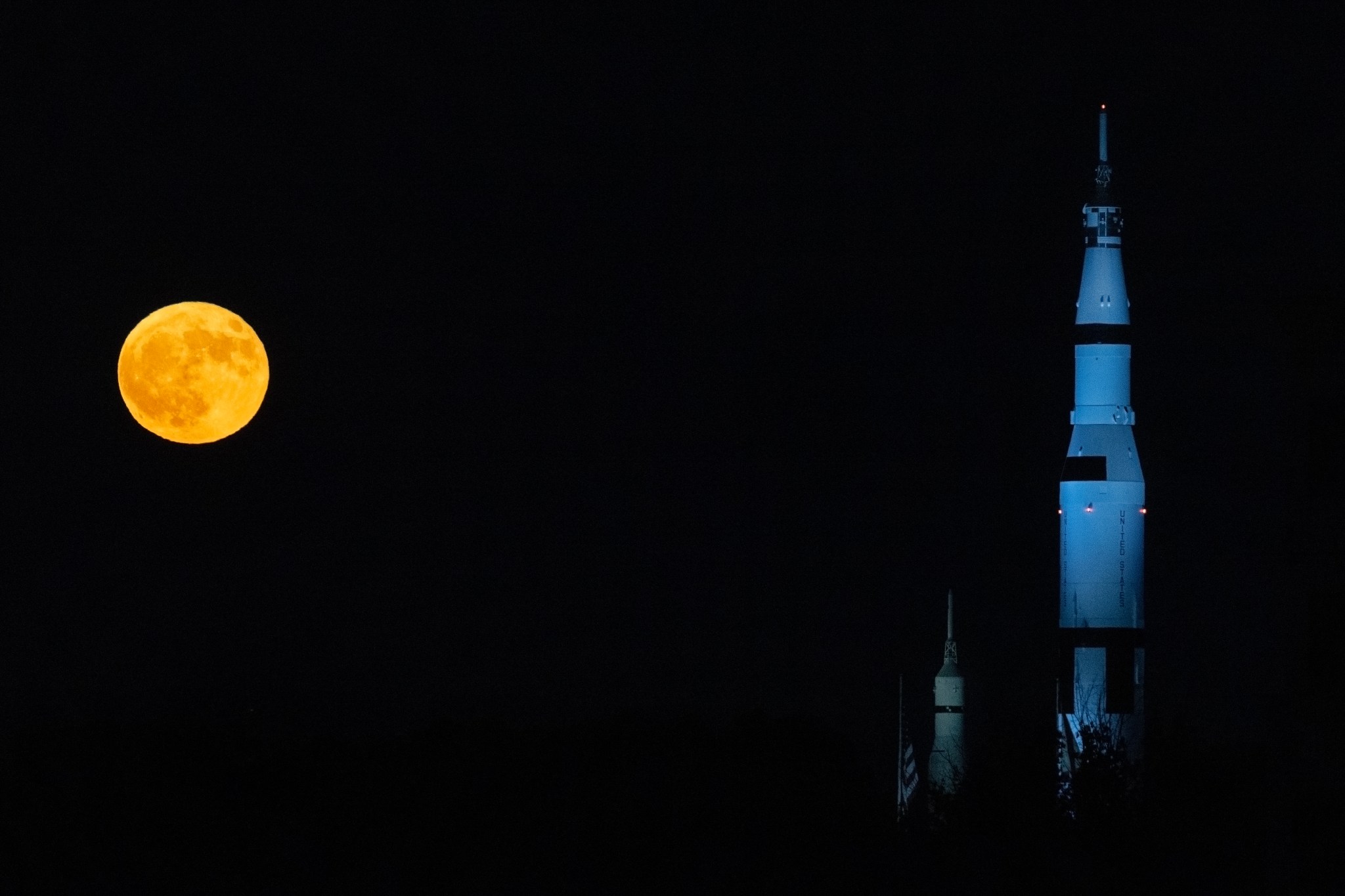
And you can say the image DeMocker captured left him, well, over the Moon. He explains how he got the photo.
“NASA photographer Eric Bordelon and I drove up from Michoud to Marshall to provide drone support for the move of the launch vehicle stage adapter of the SLS (Space Launch System) rocket to NASA’s Pegasus barge on Aug. 21,” DeMocker said. “On the trip up, we talked about possibly capturing the super Blue Moon rising that night. Using an app that shows the direction of the moonrise overlayed with a satellite image of the area, we couldn’t find a definitive spot where we thought we could get a clean line of the Moon rising with some kind of iconic Huntsville landmark. So, like good New Orleanians, we put off thinking about it until after eating. As we approached the restaurant, we caught glimpses of the Saturn V rocket at the U.S. Space & Rocket Center. We realized if we got on the roof of a nearby parking garage, we would have a clean view of the Moon rising somewhat behind it.
“The angle wasn’t perfect; I’d have preferred to be more to the right but that would have sent me plummeting off the parking garage. The clouds cooperated, the Moon rose bright and beautiful, and I got images I was happy with while Eric got a very cool time-lapse video of the Moon and the rocket.”
So, of the two Blue Moon images, which is DeMocker’s favorite?
“Yikes, that’s like choosing a child!” DeMocker said. “My favorite pictures are not always the best ones, but the ones that I didn’t think I would be able to pull off. So, while the Moon over the bridge I think is an overall better photo, it was pretty easy to plan and didn’t require much resourcefulness, so I like the rocket one better.”
DeMocker, a past Pulitzer Prize winner for team coverage of Hurricane Katrina, was honored this year with third-place finishes in two categories in NASA’s Photographer of the Year competition. He also was part of a Michoud team that captured a first-place award in the agency’s Videographer of the Year competition.
“But my favorite photos I’ve ever shot in my career have never won awards,” DeMocker said. “I like them because I thought they would be almost impossible to get when I set out after them: a drone shot of an erupting volcano in Iceland, an Iraqi woman voting in Baghdad, or my toddler quietly looking at art in the Louvre.”
Smith, a Media Fusion employee and the Marshall Star editor, supports the Marshall Office of Communications.
NASA, Boeing Optimizing Vehicle Assembly Building High Bay for Future SLS Stage Production
NASA is preparing space at the agency’s Kennedy Space Center for upcoming assembly activities of the SLS (Space Launch System) rocket core stage for future Artemis missions, beginning with Artemis III.
Teams are currently outfitting the assembly building’s High Bay 2 for future vertical assembly of the rocket stage that will help power NASA’s Artemis campaign to the Moon. During Apollo, High Bay 2, one of four high bays inside the Vehicle Assembly Building, was used to stack the Saturn V rocket. During the Space Shuttle Program, the high bay was used for external tank checkout and storage and as a contingency storage area for the shuttle.
Michigan-based Futuramic is constructing the tooling that will hold the core stage in a vertical position, allowing NASA and Boeing, the SLS core stage lead contractor, to integrate the SLS rocket’s engine section and four RS-25 engines to finish assembly of the rocket stage. Vertical integration will streamline final production efforts, offering technicians 360-degree access to the stage both internally and externally.
“The High Bay 2 area at NASA Kennedy is critical for work as SLS transitions from a developmental to operational model,” said Chad Bryant, deputy manager of the SLS Stages Office. “While teams are stacking and preparing the SLS rocket for launch of one Artemis mission, the SLS core stage for another Artemis mission will be taking shape just across the aisleway.”
Under the new assembly model beginning with Artemis III, all the major structures for the SLS core stage will continue to be fully produced and manufactured at NASA’s Michoud Assembly Facility. Upon completion of manufacturing and thermal protection system application, the engine section will be shipped to NASA Kennedy for final outfitting. Later, the top sections of the core stage – the forward skirt, intertank, liquid oxygen tank, and liquid hydrogen tank – will be outfitted and joined at Michoud and shipped to Kennedy for final assembly.
The fully assembled core stage for Artemis II arrived at Kennedy on July 23. NASA’s Pegasus barge delivered the SLS engine section for Artemis III to Kennedy in December 2022. Teams at Michoud are outfitting the remaining core stage elements and preparing to horizontally join them. The four RS-25 engines for the Artemis III mission are complete at NASA’s Stennis Space Center and will be transported to Kennedy in 2025. Major core stage and exploration upper stage structures are in work at Michoud for Artemis IV and beyond.
NASA is working to land the first woman, first person of color, and its first international partner astronaut on the Moon under Artemis. SLS is part of NASA’s backbone for deep space exploration, along with the Orion spacecraft, supporting ground systems, advanced spacesuits and rovers, the Gateway in orbit around the Moon, and commercial human landing systems. SLS is the only rocket that can send Orion, astronauts, and supplies to the Moon in a single launch.
NASA’s Marshall Space Flight Center manages the SLS Program and Michoud.
How Students Learn to Fly NASA’s IXPE Spacecraft
The large wall monitor displaying a countdown shows 17 seconds when Amelia “Mia” De Herrera-Schnering tells her teammates “We have AOS,” meaning “acquisition of signal.”
“Copy that, thank you,” Alexander Pichler replies. The two are now in contact with NASA’s IXPE (Imaging X-Ray Polarimeter Explorer) spacecraft, transmitting science data from IXPE to a ground station and making sure the download goes smoothly. That data will then go to the science team for further analysis.
At LASP, the Laboratory for Atmospheric and Space Physics, students at the University of Colorado, Boulder, can train to become command controllers, working directly with spacecraft on pointing the satellites, calibrating instruments, and collecting data. De Herrera-Schnering recently completed her sophomore year, while Pichler had trained as a student and now, having graduated, works as a full-time professional at LASP.
“The students are a key part in what we do,” said Stephanie Ruswick, IXPE flight director at LASP. “We professionals monitor the health and safety of the spacecraft, but so do the students, and they do a lot of analysis for us.”
Students also put into motion IXPE’s instrument activity plans, which are provided by the Science Operations Center at NASA’s Marshall Space Flight Center. The LASP student team schedules contacts with ground stations to downlink data, schedules observations of scientific and calibration targets, and generates the files necessary to translate the scientific operations into spacecraft actions. If IXPE experiences an anomaly, the LASP team will implement plans to remediate and resume normal operations as soon as possible.
The students take part in IXPE’s exploration of a wide variety of celestial targets. In October, for example, students monitored the transmission of data from IXPE’s observations of Swift J1727.8-1613, a bright black hole X-ray binary system. This cosmic object had been recently discovered in September 2023, when NASA’s Neil Gehrels Swift Observatory detected a gamma-ray burst. IXPE’s specialized instruments allow scientists to measure the polarization of X-rays, which contains information about the source of the X-rays as well as the organization of surrounding magnetic fields. IXPE’s follow-up of the Swift object exemplifies how multiple space missions often combine their individual strengths to paint a fuller scientific picture of distant phenomena.
Team members also conduct individual projects. For example, students analyzed how IXPE would fare during both the annular eclipse on Oct. 14, 2023, and the total eclipse that moved across North America on April 8, to make sure that the spacecraft would have adequate power while the Moon partially blocked the Sun.
While most of the students working on IXPE at LASP are engineering majors, some are physics or astrophysics majors. Some didn’t initially start their careers in STEM such as flight controller Kacie Davis, who previously studied art.
Prospective command controllers go through a rigorous 12-week summer training program working 40 hours per week, learning “everything there is to know about mission operations and how to fly a spacecraft,” Ruswick said.
Cole Writer, an aerospace engineering student, remembers this training as “nerve-wracking” because he felt intimidated by the flight controllers. But after practicing procedures on his own laptop, he felt more confident, and completed the program to become a command controller.
“It’s nice to be trained by other students who are in the same boat as you and have gone through the same process,” said Adrienne Pickerill, a flight controller who started with the team as a student and earned a master’s in aerospace engineering at the university in May.
As a teenager Writer’s interests focused on flying planes, and he saved money to train for a pilot’s license, earning it the summer after high school graduation. Surprisingly, he has found many overlaps in skills for both activities – following checklists and preventing mistakes. “Definitely high stakes in both cases,” he said.
Sam Lippincott, now a graduate student lead after serving as a command controller as an undergraduate, has been a lifelong sci-fi fan, but took a career in space more seriously his sophomore year of college. “For people that want to go into the aerospace or space operations industry, it’s always important to remember that you’ll never stop learning, and it’s important to remain humble in your abilities, and always be excited to learn more,” he said.
De Herrera-Schnering got hooked on the idea of becoming a scientist the first time she saw the Milky Way. On a camping trip when she was 10 years old, she spotted the galaxy as she went to use the outhouse in the middle of the night. “I woke up my parents, and we just laid outside and we were just stargazing,” she said. “After that I knew I was set on what I wanted to do.”
Rithik Gangopadhyay, who trained as an undergraduate command controller and continued at LASP as a graduate student lead, had been interested in puzzles and problem-solving as a kid and had a book about planets that fascinated him. “There’s so much out there and so much we don’t know, and I think that’s what really pushed me to do aerospace and do this opportunity of being a command controller,” he said.
Coding is key to mission operations, and much of it is done in the Python language. Sometimes the work of flying a spacecraft feels like any other kind of programming — but occasionally, team members step back and consider that they are part of the grand mission of exploring the universe.
“If it’s your job for a couple of years, it starts to be like, ‘oh, let’s go ahead and do that, it’s just another Tuesday.’ But if you step back and think about it on a high-level basis, it’s really something special,” Pichler said. “It’s definitely profound.”

